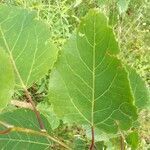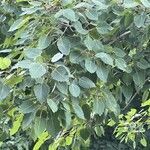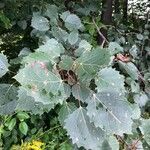Plants to 35 m, 14 dm diam.; strongly heterophyllous. Bark dark grayish brown, furrowed only basally on large trees, (light gray and smooth otherwise). Branchlets reddish brown, becoming reddish gray by third year, round, 1.3-2.5 (-5) mm diam., moderately coarse, thinly tomentose to glabrate. Winter buds reddish, proximally pubescent, (dull), not evidently resinous; terminal buds 2.5-7 (-10) mm, (glabrous or pubescent); flowering buds separated on branchlets or clustered distally, 6-9(-13) mm. Leaves: petiole distally flattened at right angle to plane of blade, 1.5-6(-11) cm, 1/2-3/4 blade length; blade ovate, (2-)4-10(-27.5) × (2-)3-8(-28.5) cm, w/l = 3/4, base broadly cuneate to subcordate, basilaminar glands (1 or) 2(-4), cup-shaped, margins not translucent, not ciliate, apex acute, abaxial surface greenish-white, resin stains absent, (glaucous), densely silky, (hairs white, relatively long, appressed) at emergence, soon becoming glabrate, adaxial bright dark green, glabrous; preformed blade margins coarsely serrate midblade, teeth (1-)5-12 (-16) on each side (graded, sharp), sinuses 0.3-4.5(-6) mm deep; neoformed blade margins finely crenate-serrate throughout, teeth (5-)15-50(-138) on each side (rounded), sinuses 0.8-1.5(-2.5) mm deep. Catkins densely (30-)50-150(-175)-flowered, (4-)6-10(-14 in fruit) cm; floral bract apex deeply cut, ciliate. Pedicels 0.2-1.5(-2 in fruit) mm. Flowers: discs narrowly cup-shaped, obviously oblique, shallowly toothed, 1-2 mm diam.; stamens 6-12; anthers truncate; ovary 2-carpelled; stigmas 2, filiform, erect. Capsules narrowly ovoid, 2-5(-6) mm, glabrous, 2-valved. Seeds (3-)6-8(-9) per placenta. 2n = 38.
More
Tree with light greenish-gray bark (darker than no. 3), becoming dark brown and furrowed in age; petioles strongly flattened; terminal buds dull brown, finely hairy; lvs tomentose-puberulent when young, especially beneath, later glabrous, dark green above, pale and glaucous beneath, often with a pair of basal glands, mostly 5–12 cm, the lowest veins strongly ascending as in no. 3 [Populus tremuloides Michx.]; lvs of short shoots coarsely and remotely toothed, with mostly 5–12 large, projecting teeth (the largest ones 1.5–6 mm deep) on each side; lvs of long shoots often with smaller and more numerous teeth; scales of catkins shallowly cleft into 5–7 lance-triangular lobes; stamens 5–12; stigmas 2, linear, bifid; frs slenderly conic, 3–5 mm, on pedicels 1–2 mm, with 5–8 seeds per placenta; 2n=38. Upland woods, often in drier soil than no. 3 [Populus tremuloides Michx.]; N.S. to Minn., s. to N.C., Tenn., and n. Mo., abundant northward. A hybrid with no. 3 is P. ×barnesii W. H. Wagner, or P. ×smithii B. Boivin.
A small tree. It grows to 20 m tall. The trunk is 30 cm across. The bark is greenish and smooth. It becomes brown and divided into flat scaly ridges with age. The leaves are 6-10 cm long and 4.5-9 cm wide. The leaves on the shorter older twigs have sharp teeth. The leaves on younger twigs are more rounded. Their edges are wavy. The leaves are dull green and paler underneath. They turn yellow in autumn. The leafstalks are long, slender and flattened. The flowers are catkins 4-6 cm long. Male and female flowers are on separate trees. The fruit are 6 mm long and narrow cone shape. There are many tiny seeds.




